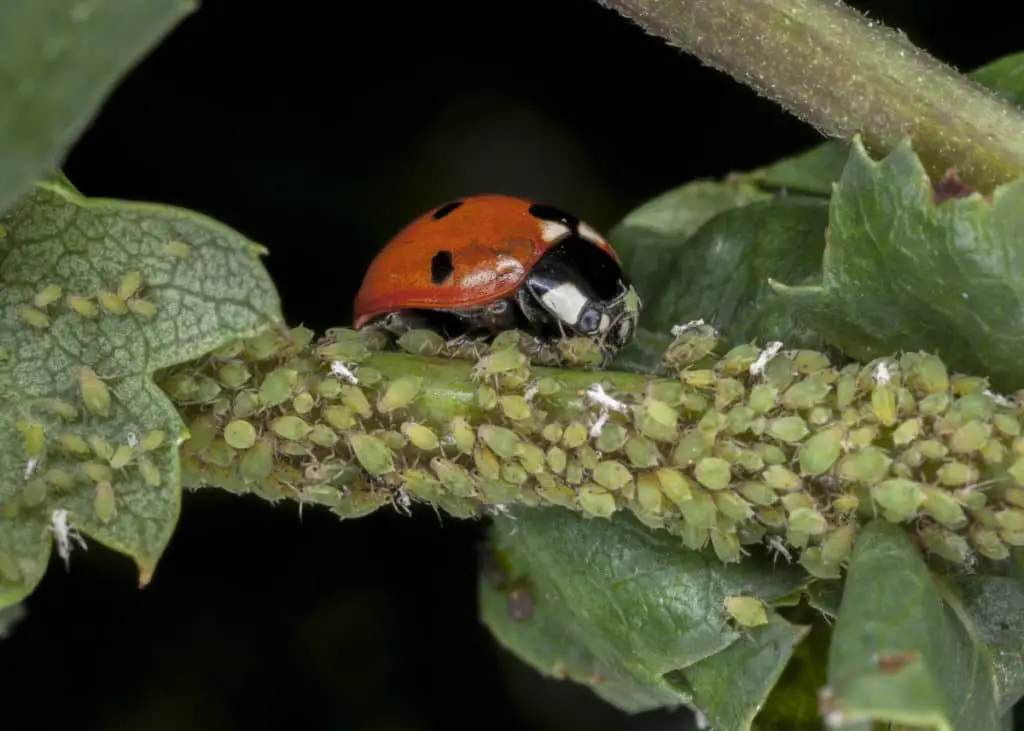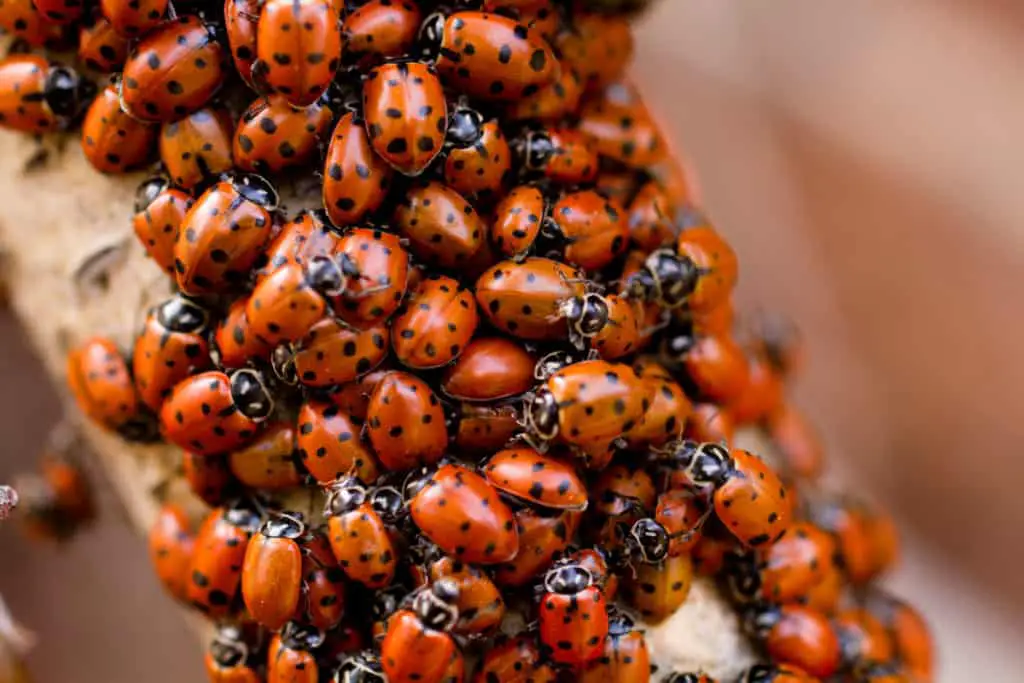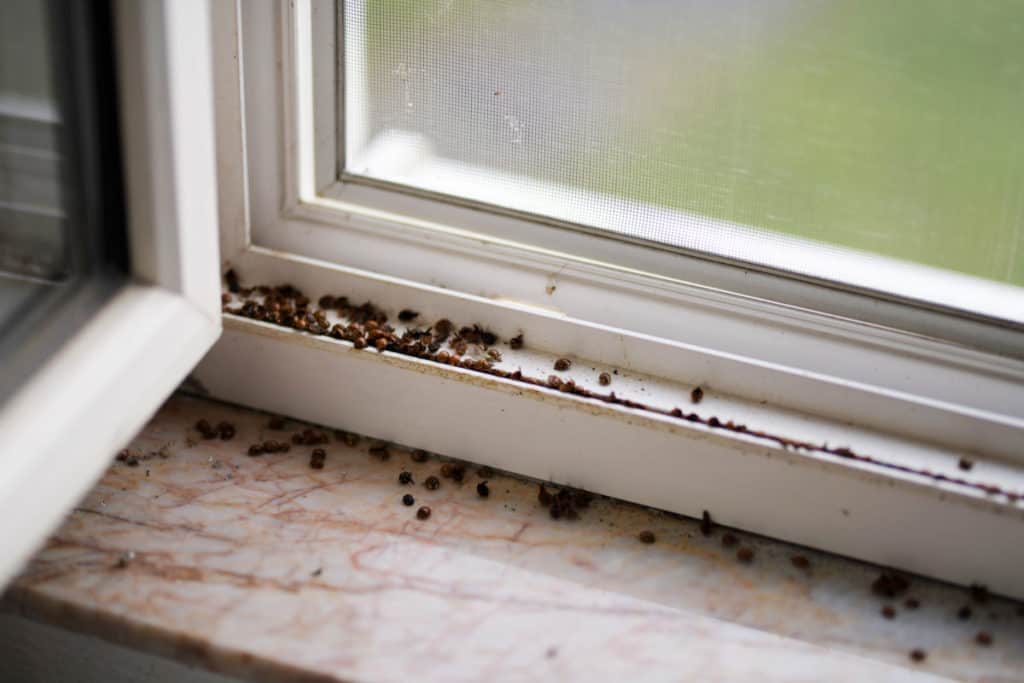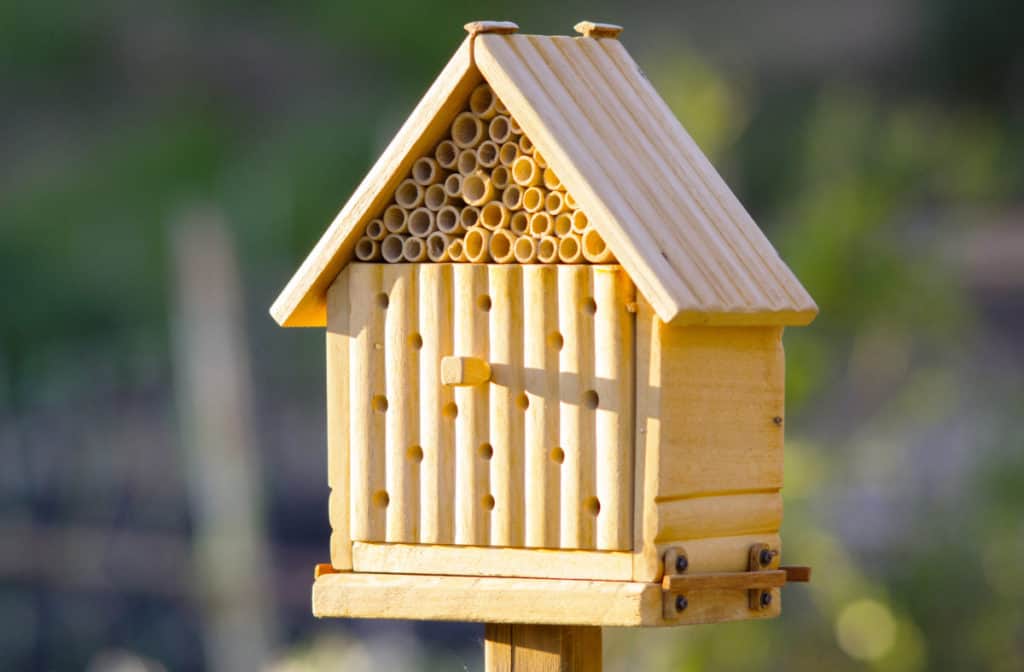Have you ever seen a ladybug gallivanting around your garden and wondered what these adorable critters do at the end of the day?
Do they go home to a nest, sleep on a leaf, or perhaps they group together for the evenings.
Ladybugs don’t make nests. What is often mistaken for nesting, in cooler regions, is ladybug congregation. At temperatures below 15°C (59°F) ladybugs release a pheromone signaling them to group together. Below 5°C (40°F) ladybugs will hibernate often in this form in order to keep warm. In warm tropical climates, this won’t happen.
Stick with us to learn more about the grouping behaviour of ladybugs, as well as their hibernation and migration patterns.
Ladybug congregation
In warmer, tropical climates, where there is not much change between winter and summer temperatures, ladybugs can be found year-round going about their business: buzzing from leaf to leaf, feasting on aphids, and everything else an average lady beetle would do.

However, in temperate climates, their behavior is significantly different. Although ladybugs tend to cover large areas of space during the summer months in search of food, they do not migrate to spend winter in a warmer place.
To survive the cold season, lady beetles congregate in large groups which is known as aggregation.
Should you be worried about seeing so many ladybugs? Will they bite you if you come close? We have written an article all about this called, Do Ladybugs Bite? They’re So Cute, Surely Not!
Why Do Ladybugs Aggregate?
According to KQED, during the winter ladybugs form groups to reproduce and cope with the limited food supply and low temperatures.
Interestingly enough, these beetles do not lay dormant for the entire winter. Instead, on warmer days they can be found moving about and repositioning, as the dotted critters are not the most socializing creatures, per se.
It is only once the temperature drops again that the beetles will re-congregate.

When Do Ladybugs Congregate?
When exactly these beetles are found congregating differs between locations. This is mainly due to the different climates as well as food availability.
According to a published paper on the temperature-dependent behaviors and cluster formation by aggregating ladybird beetles, they tend to form clusters when temperatures drop from 35 C to 15 C.
The study also found that lady beetles show a photopositive reaction when temperatures dropped from 20 C to 7 C, meaning they seek the light for warmth in this temperature range.
The study also revealed they reverted to a photonegative response when temperatures fell below 5 C, meaning below 5 degrees C they avoided exposing themselves, staying tucked away to maintain what body temperature they had.
This finding suggests a chemical change that drives these spotted beetles into dark places such as cracks in rocks and holes in the wood when the temperatures approach zero.
Where Do Lady Beetles Hibernate?
Naturally, ladybugs tuck themselves into crevices on rocks and behind tree bark.
In California, when the temperatures drop and the aphids begin to die, ladybugs take off and fly straight up. At higher altitudes, they are carried off by the winds in a similar direction towards the Bay Area where they congregate in the mountains.
Although this is a natural occurrence for ladybugs in California, it is not uncommon to find an aggregation of lady beetles inside your house during winter times.
With the addition of human infrastructure, we have provided a closer alternative for these little beetles to hide out from the cold.
It is common to find lady beetles tucked in the corners of window frames, under desks, and inside of cupboards.

Because ladybugs are photopositive in temperatures about 7 C it is common to find them congregated around flat surfaces such as windows.
However, if you live in a snowy climate, these beetles will eventually move into deep hibernation and seek darker, warmer spots.
Pheromones Involved In Ladybug Hibernation And Congregation
There are various methods used by ladybugs when it comes to hibernation, however, one particular pheromone stands out.
The H. axyridis sex hormone has been found to be present in female lady beetles. One study while analyzing the quantity of this pheromone released by females around the world found that in South East Asian countries, there was less of this chemical compared to North America and Europe.
This finding suggests that there is an increase in hormones when temperatures differ to a greater degree.
However, another study found that there was an increase in this pheromone three days after the female had fed on aphids.
These two studies are slightly contradictory as the latter suggests that lady beetles better attract mates during warmer months.
Although some studies suggest that the congregation of lady beetles is for reproduction, this sex pheromone is not the only chemical that determines ladybug aggregation locations.
Ladybug swarms tend to congregate in the same, or similar places each winter. This is due to left behind chemicals from previous years hibernation.
Leaving behind a chemical trace that can last up to 7 years, these beetles will be attracted to the same places.
These chemicals are an olfactory way of approving a particular spot as a safe hibernation destination.
How Long Do Lady Beetles Hibernate?
Hibernation patterns differ between species, and of course location.
In the U.S it is common for most species of lady beetle to begin their hibernation pattern during fall. This however is not a fixed hibernation.
As mentioned before, lady beetles will become active on warmer days, and it is only during the peak of winter, or in snowy climates that they settle in for a permanent hibernation.
In this case, ladybugs will often bury themselves beneath the soil and move into a deep sleep. Chemicals in their systems prevent them from freezing while they feed off stored body fat.
In this permanent hibernation state, a ladybug can survive for up to three months without emerging from the ground.
When temperatures begin to rise at the start of spring, their photonegative response becomes photopositive which brings them to the surface and in search for food.
It is also during this time that larvae emerge and begin their feeding frenzy.
Where Do Ladybugs Rest During Summer?
Ladybugs, similarly to humans, are diurnal, meaning that they sleep at night and are active during daylight hours.
Although they are nomadic for the most part of their life and do not congregate until winter, they do tend to rest in similar locations.
Ladybugs are very resistant to the cold but prefer to spend their nights tucked underneath some warm leaves or beneath bark.
It is common to find ladybugs resting close to a food source such as an aphid dense location
If you would like to know more about a ladybugs sleeping habits we have an article all about that called, Do Ladybugs Sleep?
Is Ladybug Congregation A Risk To Infrastructure?
Although a ladybug infestation in your home may seem annoying, it does not pose a risk to the integrity of the infrastructure.
Unlike carpenter bees or mites, lady beetles do not destroy wooden surfaces, but instead seak small crevices that already exist. That being said, the ladybug congregation inside the house can be a nuisance as spring arrives.
When they begin to awaken and travel in search of food, these cute wanderers may find themselves emerging on the inside of your house instead of into the outdoor environment.
As there is no food available to them indoors they will evidently die. Before dying these bugs leave behind a smelly volatile compound which is used as a protection method against predators.
This compound is yellow in color and likely to stain bed sheets, curtains and window sills.
How To Prevent A Ladybug Infestation In The House
Prevention is always better than a cure, and this remains true when dealing with ladybugs.
Because these tiny beetles are so beneficial to our gardens and crops from a pest control perspective, it is essential to avoid killing them.
You can either seal off all holes and cracks around the house or create ladybug houses in your garden.
So, to avoid being that kind of person who would kill a ladybug, try one of the two suggested methods.
Sealing Entry Points To Prevent Ladybugs Indoors
Ladybugs find their way into your house through small gaps in window frames, gutters, doors, and wires.
Sealing these holes during late spring is the best permanent way to prevent a congregation of lady beetles inside your home during the following fall.
Using either silicon, food filler, or cement for larger holes will mean that there is no entry point for these little creatures to enter.
It should however be kept in mind that the best time to do this is late spring or early summer when the beetles are at their most active and will not be seeking an indoor space.
If you seal your house during late summer or fall, there may already be ladybugs inside and it will only be the following spring that you can deal with them.
Ladybug Houses
While ladybug houses are sold in gardening shops and are overwhelmingly adorable, they will not entirely prevent the beetles from entering your house. That’s because your house will always be warmer than outside.

However, if your entrances are sealed, these ladybug houses can provide an alternative for the beetles which will encourage them to stay in your garden over winter, and therefore be more abundant during the spring.
The Wrap Up
Ladybugs are nomadic creatures who spend the majority of spring and summer months flying around in search of food.
As temperatures drop this behavior changes.
Lady beetles do not build nests of any sort, but during winter months will congregate in the same place in order to mate, stay warm, and deal with the limited food sources.
Although this may happen inside your house, it is best to prevent a congregation instead of killing these helpful little beetles.
